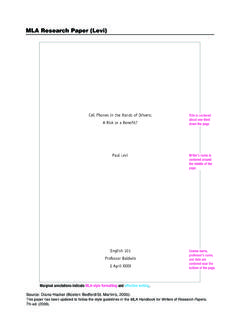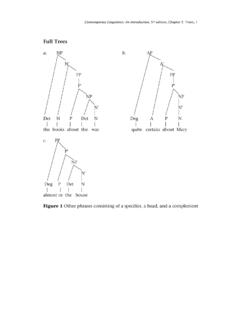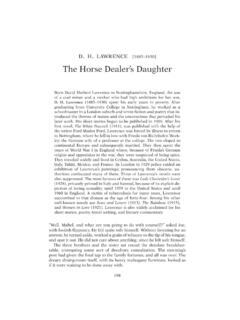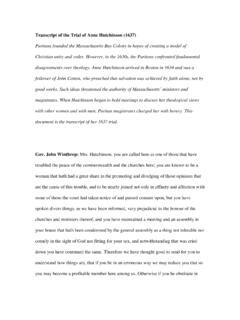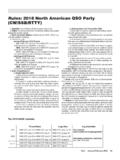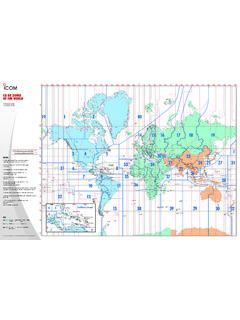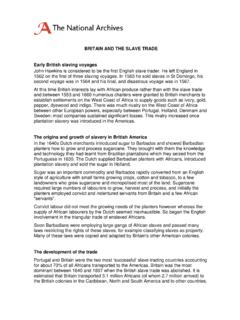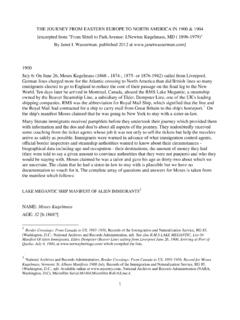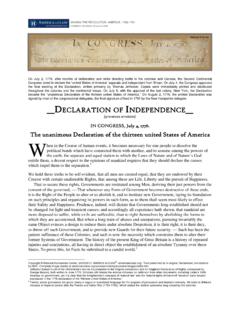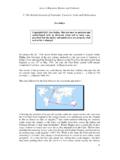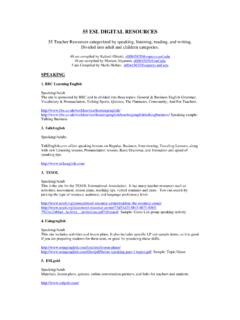Transcription of Colonial America in the Eighteenth Century
1 59 CHAPTER 5 Colonial America in the Eighteenth Century 1701 1770 CHAPTER LEARNING OBJECTIVES After reading and studying this chapter, students should be able: Understand how Eighteenth - Century Colonial population growth and economic growth were linked. Explain how the market economy developed in New England and in what ways Puritanism was weakened. Discern how the population growth of the middle colonies, particularly Pennsylvania, differed from that of New England and the South, including the role played by immigration. Recognize how the large influx of slaves into the southern colonies shaped the region s economy, society, and politics.
2 Identify the shared experiences that served to unify the culture of the disparate colonies of british north America . Comprehend how the policies of the british Empire provided a common framework of political expectations and experiences for American colonists, including the relations between the colonists and their Native American neighbors both in british north America and in Spanish California. ANNOTATED CHAPTER OUTLINE The following annotated chapter outline will help you review the major topics covered in this chapter. I. A Growing Population and Expanding Economy in british north America 1. british America experienced a tremendous population explosion during the Eighteenth Century , rising from 250,000 colonists in 1700 to over 2 million in 1770. 2. The growth and diversity of the Colonial population in the Eighteenth Century stemmed from both natural increases and immigration, which shifted the ethnic and racial balance of the colonies. 3. The Colonial economy also expanded during the Eighteenth Century .
3 4. In 1700, nearly all the colonists lived within fifty miles of the Atlantic coast. 5. The almost limitless wilderness stretching westward made land relatively cheap; land used for agriculture was worthless without labor, and with the rapidly expanding economy the demand for labor in the colonies was high. 60 CHAPTER 5 Colonial America IN THE Eighteenth Century II. New England: From Puritan Settlers to Yankee Traders A. Natural Increase and Land Distribution 1. The burgeoning New England population grew mostly by natural increase, much as it had during the seventeenth Century and soon pressed against the limited amount of land. 2. The perils of childbirth gave wives a shorter life expectancy than husbands, but wives often lived to have six, seven, or eight babies. 3. By the Eighteenth Century , the original land allotments had to be subdivided to accommodate grandsons and great-grandsons, causing many plots of land to become too small for subsistence.
4 4. During the Eighteenth Century , Colonial governments in New England abandoned the seventeenth- Century policy of granting land to towns and sold land directly to individuals, including speculators. 5. Money, rather than membership in a community bound by a church covenant, determined whether a person could buy land; settlement on individual farms meant that colonists regulated their behavior in newly settled areas by their own individual choices and not those of a larger community. B. Farms, Fish, and Atlantic Trade 1. New England farmers grew food for their families, but their fields did not produce a huge marketable surplus. 2. As consumers, New England farmers were at the forefront of a diversified commercial economy that linked remote farms to markets throughout the world. 3. Fish accounted for more than one-third of New England s Eighteenth - Century exports; livestock and timber made up another one-third; Atlantic commerce provided jobs for laborers, tradesmen, ship captains, clerks, merchants and sailors.
5 4. Merchants, the largest and most successful of whom lived in Boston, dominated New England commerce; by 1770, the richest 5 percent of Bostonians owned half of the cities wealth. 5. During the Eighteenth Century , the incidence of genuine poverty did not change much from patterns established in the seventeenth Century , with about 5 percent qualifying for poor relief in the Eighteenth Century . 6. People of African ancestry (almost all of them slaves) numbered more than fifteen thousand by 1770 and lived in towns where they worked as domestic servants and laborers. 7. By 1700, Yankee traders had replaced Puritan saints as the symbolic New Englanders. III. The Middle Colonies: Immigrants, Wheat, and Work A. German and Scots-Irish Immigrants 1. Germans made up the largest contingent of migrants from the European continent to the middle colonies. 2. German immigrants included artisans and merchants, but the great majority of them were farmers and laborers.
6 3. By the 1720s, German immigrants wrote back to their friends and relatives, extolling the virtues of life in the New World, which encouraged yet more Germans to emigrate. Similar motives propelled the Scots-Irish to come to the middle colonies. 4. German immigrants belonged to a variety of Protestant churches while Scots-Irish were generally Presbyterians; both groups were clannish, residing among relatives or neighbors from the old country. 5. Scots-Irish immigrants flooded british north America during the decades before the American Revolution. 6. Many German immigrants were forced to become redemptioners, a variant of indentured servants; Scots-Irish immigrants paid for their passage by CHAPTER 5 Colonial America IN THE Eighteenth Century 61 contracting as indentured servants before they sailed to the colonies. B. God Gives All Things to Industry : Urban and Rural Labor 1. New settlers, whether free or in servitude, poured into the middle colonies because they perceived unparalleled opportunities, particularly in Pennsylvania.
7 2. Most servants in the middle colonies worked in Philadelphia, New York City, or one of the smaller towns or villages. 3. Artisans, small manufacturers, and shopkeepers prized the labor of male servants; female servants made valuable additions to households, where nearly all of them cleaned, washed, cooked, or minded children. 4. Slaves comprised a relatively small percentage of the total population of the middle colonies because only the affluent could afford them. 5. Small numbers of slaves managed to obtain their freedom, but free African Americans did not escape whites firm convictions about black inferiority and white supremacy; African Americans became scapegoats for European Americans suspicions and anxieties. 6. Immigrants swarmed to the middle colo-nies because of the availability of land. 7. Pennsylvania s policy of negotiating with Indian tribes to purchase additional land reduced violent frontier clashes even though the Penn family sometimes pushed such land agreements to the limit and beyond.
8 8. Owners of the huge estates in New York s Hudson valley preferred to rent rather than sell their land, and therefore attracted fewer immigrants. 9. The price of farmland varied, depending on soil quality, access to water, distance from a market town, and the extent of improvements. 10. Farmers made the middle colonies the breadbasket of north America , planting a wide variety of crops to feed their families as well as wheat in abundance. 11. Flour milling was the number one industry and flour the number one export, constituting nearly three-fourths of all exports from the middle colonies. 12. The standard of living in rural Pennsylvania was probably higher than in any other agricultural region of the Eighteenth - Century world. 13. By 1776, Philadelphia was at the center of the crossroads of trade in wheat exports and English imports and boasted a population greater than any other city in the british empire, except London. 14. Many of Philadelphia s wealthiest mer-chants were Quakers and influenced aspiring tradesmen like Benjamin Franklin, whose popular Poor Richard s Almanack preached the likelihood of long-term rewards for tireless labor.
9 IV. The Southern Colonies: Land of Slavery A. The Atlantic Slave Trade and the Growth of Slavery 1. The number of southerners of African ancestry rapidly increased from just over 20,000 in 1700 to well over 400,000 in 1770. 2. Southern colonists clustered into two distinct geographic and agricultural zones: the upper South, which specialized in growing tobacco, and the lower South, which specialized in growing rice and indigo. 3. The enormous growth of the South s slave population occurred through natural increase and the flourishing Atlantic slave trade, which subjected hundreds of thousands of Africans to the infamous Middle Passage. 4. In 1789, Olaudah Equiano published his account of the Middle Passage and his experiences as a slave. 5. Most slaves who were brought into the southern colonies came directly from Africa, and almost all the ships that 62 CHAPTER 5 Colonial America IN THE Eighteenth Century brought them belonged to british merchants. 6. Mortality during the Middle Passage varied considerably from ship to ship, but on average, about 15 percent of slaves perished during the journey.
10 7. Individual planters purchased, at any one time, a relatively small number of newly arrived Africans (called new Negroes ) and relied on already enslaved Africans to help acculturate or season new slaves to the physical as well as the cultural, environment of the southern colonies. 8. Planters preferences for slaves from specific regions of Africa aided slaves acculturation to the routines of bondage in the southern colonies because enough linguistic and cultural similarities existed that they could usually communicate with other Africans from the same region. 9. Slaves who had endured the Middle Passage were poorly nourished, weak, and sick; they encountered the alien diseases of north America without having developed a biological arsenal of acquired immunities. 10. The slave population grew due to a high rate of natural increase and by the 1740s, the majority of southern slaves were country-born. B. Slave Labor and African American Culture 1.

